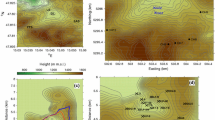Summary
Turbulent erosion of the cold air pool (CAP) in a basin was investigated with a goal of evaluating Petkovšek’s (1985, 1992) hypothesis that wind velocity above a cold air pool must increase with time in order to destroy a cold air pool by the turbulent erosion mechanism. Measured wind data at surface stations above the CAP in the Ljubljana basin (in central Slovenia) show an increasing wind velocity with time, while coincident sodar data show the simultaneous time evolution of a vertical wind profile inside the basin, ending with complete erosion of the CAP. Numerical modelling with the MM5 non-hydrostatic model (Dudhia 1993, with Janjić’s 1990 and 1994 turbulent package of Mellor-Yamada level 2.5) in an idealized basin proved that when the wind exceeds a certain threshold velocity, the CAP starts to erode. The process stops, however, if the wind speed does not increase further. If the wind velocity continues to increase, the simulation leads to complete erosion of the CAP. For comparison with a real basin, erosion was also simulated in more complicated relief (one roughly representing the Ljubljana basin). The general results of the simulation are basically similar to the ones in the idealized basin.
Similar content being viewed by others
Author information
Authors and Affiliations
Additional information
Received June 21, 2001 Revised November 13, 2001
Rights and permissions
About this article
Cite this article
Rakovec, J., Merše, J., Jernej, S. et al. Turbulent dissipation of the cold-air pool in a basin:comparison of observed and simulated development. Meteorol Atmos Phys 79, 195–213 (2002). https://doi.org/10.1007/s007030200003
Issue Date:
DOI: https://doi.org/10.1007/s007030200003




